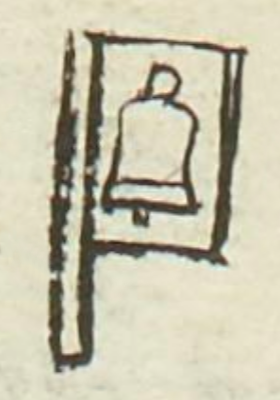Pantzilin (MH513r)
This black-line drawing of the compound glyph for the personal name Pantzilin (perhaps "Banner Bell") is attested here as a man's name. It shows an upright banner facing toward the viewer's right. On the flag is a drawing of a flared bell in a European style. The bell has a loop at the top for hanging and a clapper emerging from the broad flare at the bottom of the bell. One horizontal line appears just above the bottom of the bell. The -tzilin part of the name comes from the verb, tzilini, to ring a bell.
Stephanie Wood
This glyph does not visually capture the sound of a bell ringing, which would be really interesting. The autonomous-era type of bell (coyolli) as shown on folio 44 recto of the Codex Mendoza (see below) has little sound scrolls coming out of the bottom. The coyolli (jingle bells) were usually small copper or gold bells, but this one for the verbs tzilini or tzilinia looks more like a church bell, showing Spanish influence. It has a wide mouth and a protruding clapper. The loop at the top does coincide with the loop of some of the coyolli bells, which could hang from jewelry or from a leather thong around ankles, for instance, when danced. Juan José Batalla Rosado (2018, 96) includes the various glyphs related to the verbs tzilini/tzizlinia in his study of visual loans, given that the iconography of these bells has been greatly influenced by exposure to European bells. He also points to the new occupation of bell ringer and its seeming neologisms tlatzilini or tlatziliniani (2018, 97).
juao pātzilin
Juan Pantzilin
Stephanie Wood
1560
Jeff Haskett-Wood and Stephanie Wood
campanas, banderas, campanillas, pinjantes, metales, nombres de hombres

pani(tl), banner, https://nahuatl.wired-humanities.org/content/panitl
tzilini, to ring a bell, https://nahuatl.wired-humanities.org/content/tzilini
Matrícula de Huexotzinco, folio 513r, World Digital Library, https://www.loc.gov/resource/gdcwdl.wdl_15282/?sp=105&st=image
This manuscript is hosted by the Library of Congress and the World Digital Library; used here with the Creative Commons, “Attribution-NonCommercial-ShareAlike 3.0 License” (CC-BY-NC-SAq 3.0).


